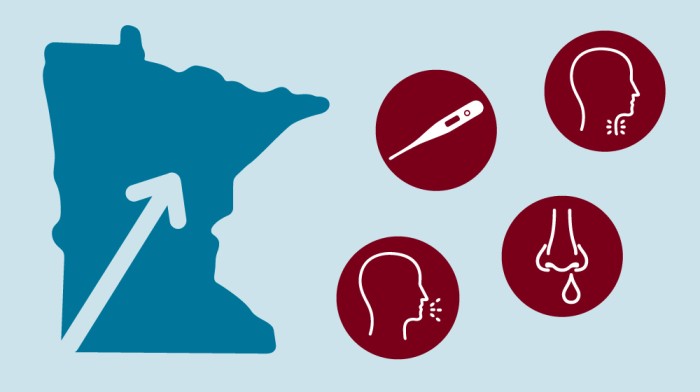
Fevers, sneezes, runny noses and sore throats: the unwelcome symptoms of this year’s flu season have arrived with gusto as new cases and hospitalizations in Minnesota continue to grow.
Jill Foster, MD, a pediatric infectious diseases physician with University of Minnesota Physicians (M Physicians), expects cases to continue rising. “Christmas through January and February are really the worst in terms of case numbers,” Dr. Foster says, noting, “We are on track for a regular flu season.”
More cases, more risk
Last year, flu cases were fewer and further between as a result of masking, social distancing, distance learning and other precautions many Minnesotans took to protect themselves from COVID-19, Dr. Foster observed.
Now, as many people have gathered over the holidays, more are catching the flu. “We’re also seeing a lot of flu cases in children, which means many of those kids will be spreading influenza to their parents, teachers and other adults,” Dr. Foster says. The Minnesota Department of Health (MDH) has reported 106 flu outbreaks in schools and 166 hospitalizations for the flu since the beginning of this year’s flu season. The total number of flu hospitalizations last year was just 35.
Low levels of flu vaccination also share responsibility. “Unfortunately, we are seeing low flu vaccination rates. We believe a lot of people are skipping the flu vaccine this year and instead are opting for the COVID-19 vaccine,” Dr. Foster says. “It’s great that people are getting vaccinated for COVID-19, but we need to protect ourselves from the flu as well.”
What to do to if someone gets the flu
Flu symptoms typically come on quickly, Dr. Foster notes. These include fever, runny nose, sore throat and sneezing that usually start to get better after the fourth day of feeling sick.
While it may be easy to confuse the flu with COVID-19, COVID-19 presents differently and symptoms can sneak up over the course of a week or two after someone has been exposed.
“You get a little bit sick and then it gets worse. Likely symptoms include a fever, dry cough and shortness of breath,” says Dr. Foster. It’s also possible to get both the flu and COVID-19 at the same time, which will likely make symptoms worse.
If anyone comes down with any flu or COVID-19 symptoms, Dr. Foster emphasizes that it is important to follow these steps:
- Stay home
- Give yourself time to rest and sleep
- Drink warm fluids
- Take pain relievers if necessary
Patients should also get tested and consider talking to their doctor.
If someone is at high risk for flu complications, a few specific treatments may be available. They typically work best when taken within one to two days after symptoms begin and require a prescription.
How to stay healthy
The best way to keep the flu away, Dr. Foster says, is to get the flu shot. She also emphasizes that it's not too late for it to make a difference. These vaccines are widely available for patients as young as six months and only take a few minutes to get.
Additional ways to stay healthy include:
- Washing hands often for at least 20 seconds
- Covering sneezes and coughs
- Wearing masks in public places
By getting the flu shot and following these steps this winter, many Minnesotans can spend more time doing what they love and less time spending it with the flu.
